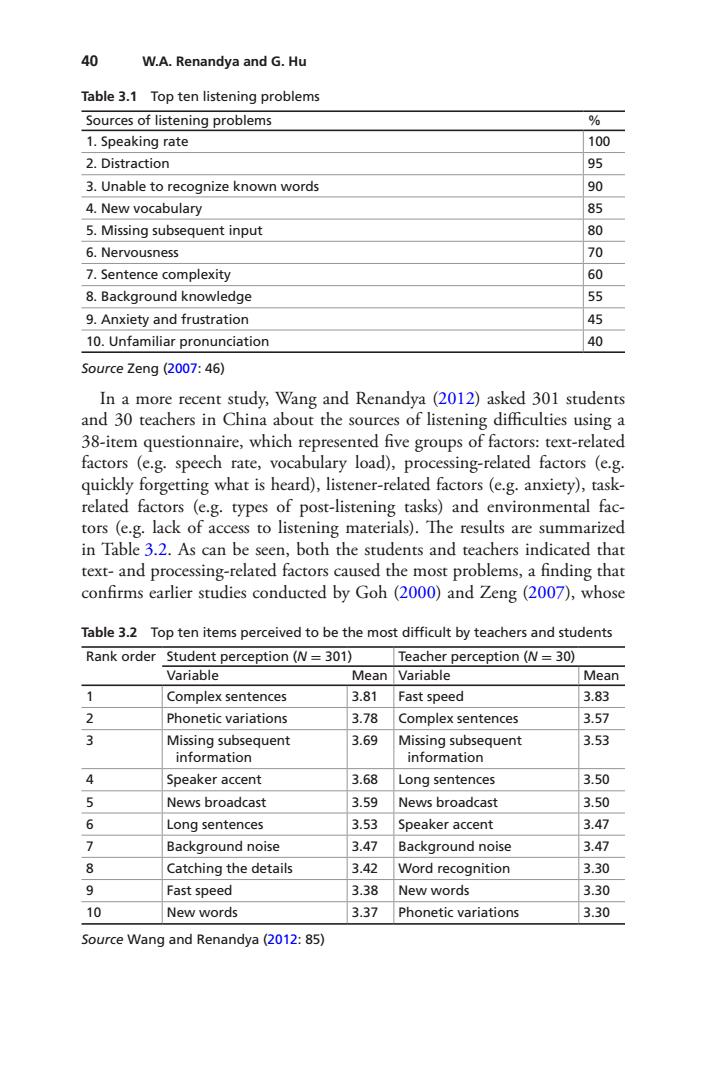正在加载图片...

0 WA.Renandva and G.Hu Table 3.1 Top ten listening problems Sources of listening problems 976 1.Speaking rate 1100 2.Distraction 95 3.Unable to recognize known words 90 4.New vocabulary 85 5.Missing subsequent input 80 6.Nervousness 170 7.Sentence complexity /60 8.Background knowledge 55 9.Anxiety and frustration 95 10.Unfamiliar pronunciation 40 Source Zeng(2007:46) In a more recent study,Wang and Renandya (2012)asked 301 students and 30 teachers in China about the sources of listening difficulties using a 38-item questionnaire,which represented five groups of factors:text-related factors (e.g.speech rate,vocabulary load),processing-related factors (e.g quickly forgetting what is heard),listener-related factors (e.g.anxiety),task- related factors (e.g.types of post-listening tasks)and environmental fac tors (e.g.lack of access to listening materials).The results are summarized in Table 3.2.As can be seen,both the students and teachers indicated that text-and processing-related factors caused the most problems,a finding that confirms earlier studies conducted by Goh (2000)and Zeng (2007),whose Table 3.2 Top ten items perceived to be the most difficult by teachers and students Rank order Student perception(N=301) Teacher perception (N=30) Variable Mean Variable Mean Complex sentences 3.81 Fast speed 3.83 Phonetic variations 3.78 Complex sentences 3.57 Missing subsequent 3.69 Missing subsequent 3.53 information information Speaker accent 3.68 Long sentences 3.50 News broadcast 3.59 News broadcast 3.50 Long sentences 3.53 Speaker accent 3.47 Background noise 3.47 Background noise 3.47 Catching the details 3.42 Word recoanition 3.30 Fast speec 3.38 New words 330 10 New words 3.37 Phonetic variations 3.30 Source Wang and Renandya(2012:85)40 W.A. Renandya and G. Hu In a more recent study, Wang and Renandya (2012) asked 301 students and 30 teachers in China about the sources of listening difculties using a 38-item questionnaire, which represented fve groups of factors: text-related factors (e.g. speech rate, vocabulary load), processing-related factors (e.g. quickly forgetting what is heard), listener-related factors (e.g. anxiety), taskrelated factors (e.g. types of post-listening tasks) and environmental factors (e.g. lack of access to listening materials). Te results are summarized in Table 3.2. As can be seen, both the students and teachers indicated that text- and processing-related factors caused the most problems, a fnding that confrms earlier studies conducted by Goh (2000) and Zeng (2007), whose Table 3.1 Top ten listening problems Source Zeng (2007: 46) Sources of listening problems % 1. Speaking rate 100 2. Distraction 95 3. Unable to recognize known words 90 4. New vocabulary 85 5. Missing subsequent input 80 6. Nervousness 70 7. Sentence complexity 60 8. Background knowledge 55 9. Anxiety and frustration 45 10. Unfamiliar pronunciation 40 Table 3.2 Top ten items perceived to be the most diffcult by teachers and students Source Wang and Renandya (2012: 85) Rank order Student perception (N = 301) Teacher perception (N = 30) Variable Mean Variable Mean 1 Complex sentences 3.81 Fast speed 3.83 2 Phonetic variations 3.78 Complex sentences 3.57 3 Missing subsequent information 3.69 Missing subsequent information 3.53 4 Speaker accent 3.68 Long sentences 3.50 5 News broadcast 3.59 News broadcast 3.50 6 Long sentences 3.53 Speaker accent 3.47 7 Background noise 3.47 Background noise 3.47 8 Catching the details 3.42 Word recognition 3.30 9 Fast speed 3.38 New words 3.30 10 New words 3.37 Phonetic variations 3.30